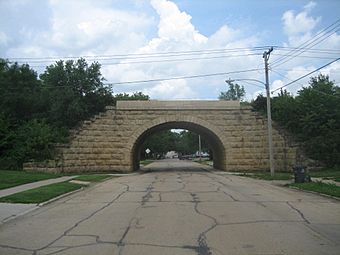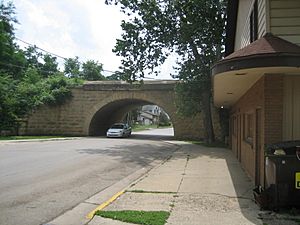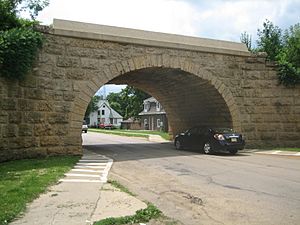Illinois Central Stone Arch Railroad Bridges facts for kids
Quick facts for kids |
|
|
Illinois Central Stone Arch Railroad Bridges
|
|

The stone arch bridge over Second Street in Dixon, Illinois.
|
|
| Location | W. First, W. Second, & W. Third Sts. between Monroe & College Aves., Dixon, Illinois |
|---|---|
| Area | 2 acres (0.81 ha) |
| Built | 1852-1855 |
| Architect | Robert F. Laing |
| NRHP reference No. | 87002048 |
| Added to NRHP | December 2, 1987 |
The Illinois Central Stone Arch Railroad Bridges are three old bridges made of limestone in Dixon, Illinois, USA. These bridges were built a long time ago, between 1852 and 1855. This was when the Illinois Central Railroad was first building its train tracks across Illinois.
A man named Robert F. Laing designed them. He worked for a company called Laing and Douglas Construction. Even though the bridges look similar, they are all a bit different in height. They were used by trains until 1985. In 1987, these three special bridges were added to the U.S. National Register of Historic Places. This means they are important historical sites.
History of the Illinois Central Railroad Bridges
These three bridges were built from 1852 to 1855. They used limestone found right there in the local area. This was part of the Illinois Central Railroad (ICRR) building its very first train lines. These lines would cross the whole state of Illinois.
In the summer of 1851, the Illinois Central started laying its first tracks. They began between two towns called Mendota and Amboy. On March 6, 1852, the railroad announced the path it would take through Dixon. By 1853, this section of track was finished. The first locomotives, or train engines, arrived in Amboy on November 27, 1853. Amboy's train station later became a main office for the railroad's northern area.
The part of the railroad that went through Dixon was built from 1852 to 1855. It was partly on a raised area of ground, about 15-foot (4.6 m) high. This raised area would hold the three bridges when the project was done. The bridges were made from limestone from Dement's Quarry. This quarry was just up the Rock River from Dixon.
The very first train crossed over these three bridges on February 1, 1855. The bridges are located over West First, Second, and Third Streets. When the train arrived, the local newspaper wrote about it. They said it was "like a huge chariot of fire on a monstrous beast." The bridges were used by the railroad until December 21, 1985.
How the Stone Arch Bridges Were Designed
The three bridges look alike, but they have different heights. Their heights depended on the natural shape of the land. Robert Finley Laing from Laing and Douglas Construction Company designed them. His company worked for the Illinois Central Railroad from 1852 to 1853.
Besides these three bridges in Dixon, Laing also designed another bridge. This one had stone supports and carried the ICRR over the Rock River towards Freeport. The three stone bridges in Dixon are built into a 15-foot-high (4.6 m) raised bank of earth. This bank stretches from West Seventh Street to the Rock River. The three stone arch bridges are part of this long raised area.
The yellow-colored limestone blocks were cut to fit together perfectly. They don't use any glue or metal to hold them. Instead, special stone "keys" are cut into the rocks. These keys stop the stones from slipping out of place. The stone is a type called ashlar masonry. This means the stones are carefully cut and shaped.
The way the stone is finished changes depending on where it is on the bridge. The stones that form the arch itself have a smooth, chiseled look. The stones on the side walls and at the base of the arches have a rougher, "rock face" finish. The bridges have hardly been changed since they were built. Only a small amount of tuckpointing (repairing mortar joints) was done between 1912 and 1915.
Each bridge has a different height for trains to pass under. The bridge over First Street is 14 ft (4.3 m) high. The Second Street bridge is the tallest at 15 ft (4.6 m) high. The Third Street Bridge is the shortest, at 12 ft (3.7 m) high. Because it's so short, the Third Street Bridge is sometimes called "Little Sister."
All three bridges have the same arch width, which is 28 ft (8.5 m). However, their lengths (or depths) are different. The longest bridge is the "Little Sister" Bridge, which is 38-foot (12 m) deep. The bridge at First Street is 28 ft (8.5 m) deep. The bridge at Second Street is 34 ft (10 m) deep. The side walls on each bridge extend 33 ft (10 m) at their bases.
Why These Bridges Are Important
These three bridges are the only ones of their kind still standing in Lee County, Illinois. They are also important because they are connected to the very beginning of the Illinois Central Railroad. When the Illinois Central Railroad came to Dixon, new businesses and industries followed. This helped Dixon to grow and become successful. The number of people living in the Dixon area increased a lot over the years, directly because the ICRR arrived.
At one point, the city government wanted to tear down these old arches. But the people living in Dixon protested and saved the bridges! The three bridges were officially listed on the U.S. National Register of Historic Places on December 2, 1987. This means they are recognized as important historical landmarks.



